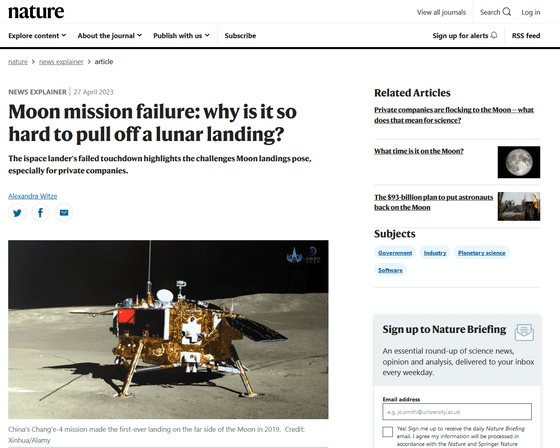A correspondent of the scientific journal Nature talks about 'how difficult the moon landing mission is'

On April 26, 2023, the ispace lander, which challenged the first private company to land on the moon, reached the moon, but unfortunately
Moon mission failure: why is it so hard to pull off a lunar landing?
https://doi.org/10.1038/d41586-023-01454-7

The only successful soft-landings on the moon have been space agency spacecraft involving the governments of China, the Soviet Union, and the United States. In addition, China is the only country that has landed on the moon since the 1970s.
According to Steven Indik, director of space systems at space engineering company Honeybee Robotics, the difficulty of landing on the moon lies in ``the number of variables to consider''. For example, the moon is known to have less gravity, little atmosphere, and more dust than Earth, and engineers predict how spacecraft will interact with such an environment. is needed.

Such predictions and landing tests require a large amount of money and time, and tests are necessary anyway to prove that they can land in as many scenarios as possible. 'Still, nothing is guaranteed,' says Indik.
In fact, ispace was the second private company ever to attempt a moon landing. In 2019, three years before ispace, an attempt by the Israeli company SpaceIL also ended in a crash landing, but just before communication was cut off due to machine trouble, the lunar probe sent the last picture before the collision to the earth. I also know that I was.

by Israel To The Moon
A mission to the moon, about 384,000 km from Earth, is much more difficult than sending a satellite into low-Earth orbit, and even missions that don't plan to land can fail early on. For example, NASA's small spacecraft 'Lunar Flashlight', which was launched to observe lunar ice, may not reach its intended orbit because its propulsion system malfunctioned shortly after launch. About.

Even if a lander were to come close to the moon, it would have to travel to the surface with no guidance system and little atmosphere to help slow it down. Even if the lunar surface is just a few kilometers away, it can quickly and autonomously deal with a flurry of challenges, such as sensors being disturbed by the large amounts of dust that the exhaust fumes have lifted up from the surface. I have to.
“Private companies are expected to land on the moon without government assistance and without many of the failures and successes experienced by government-sponsored space agencies,” Indyk said. It's a terrible story to ask for such a thing.'

Related Posts:
in Science, Posted by log1p_kr







